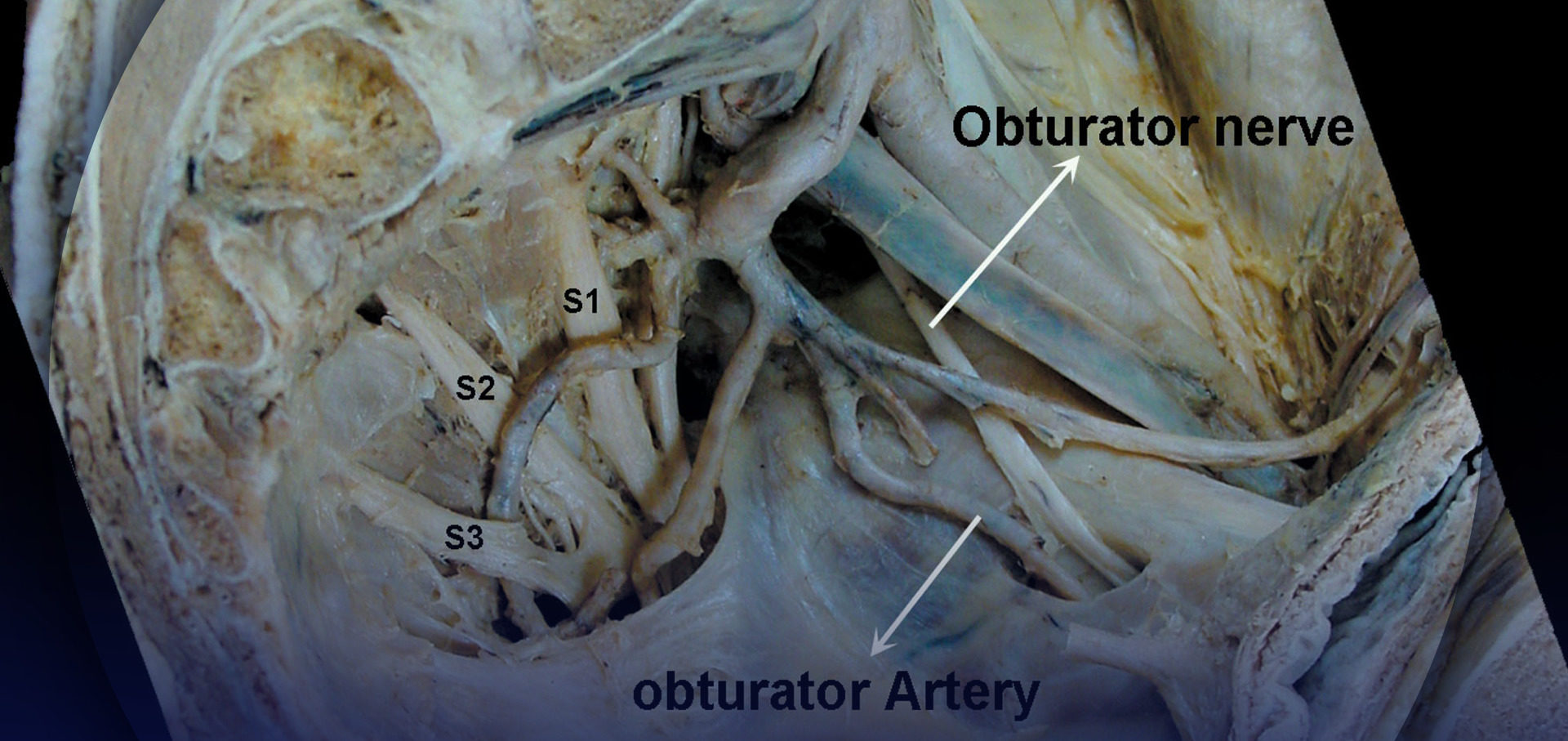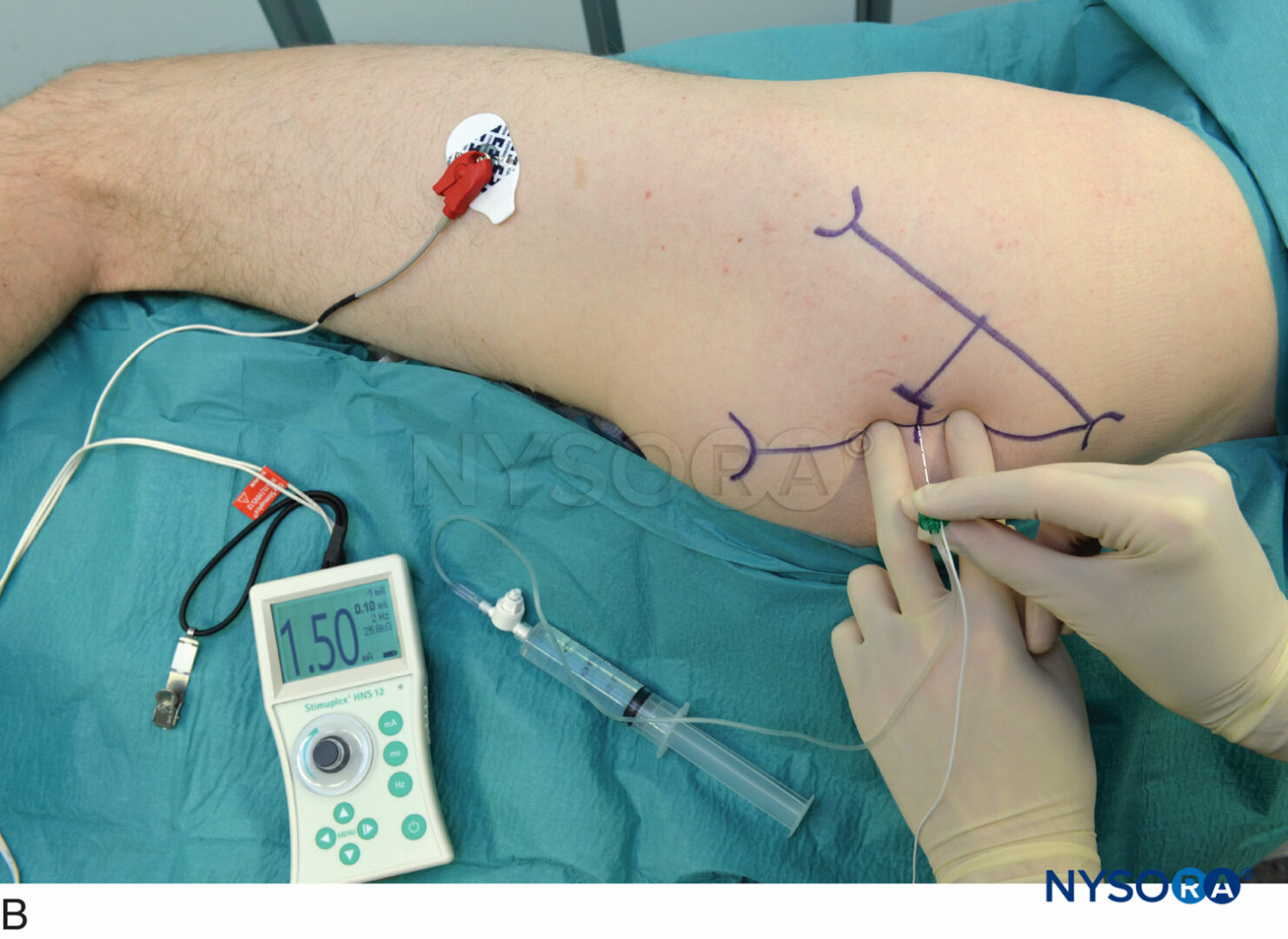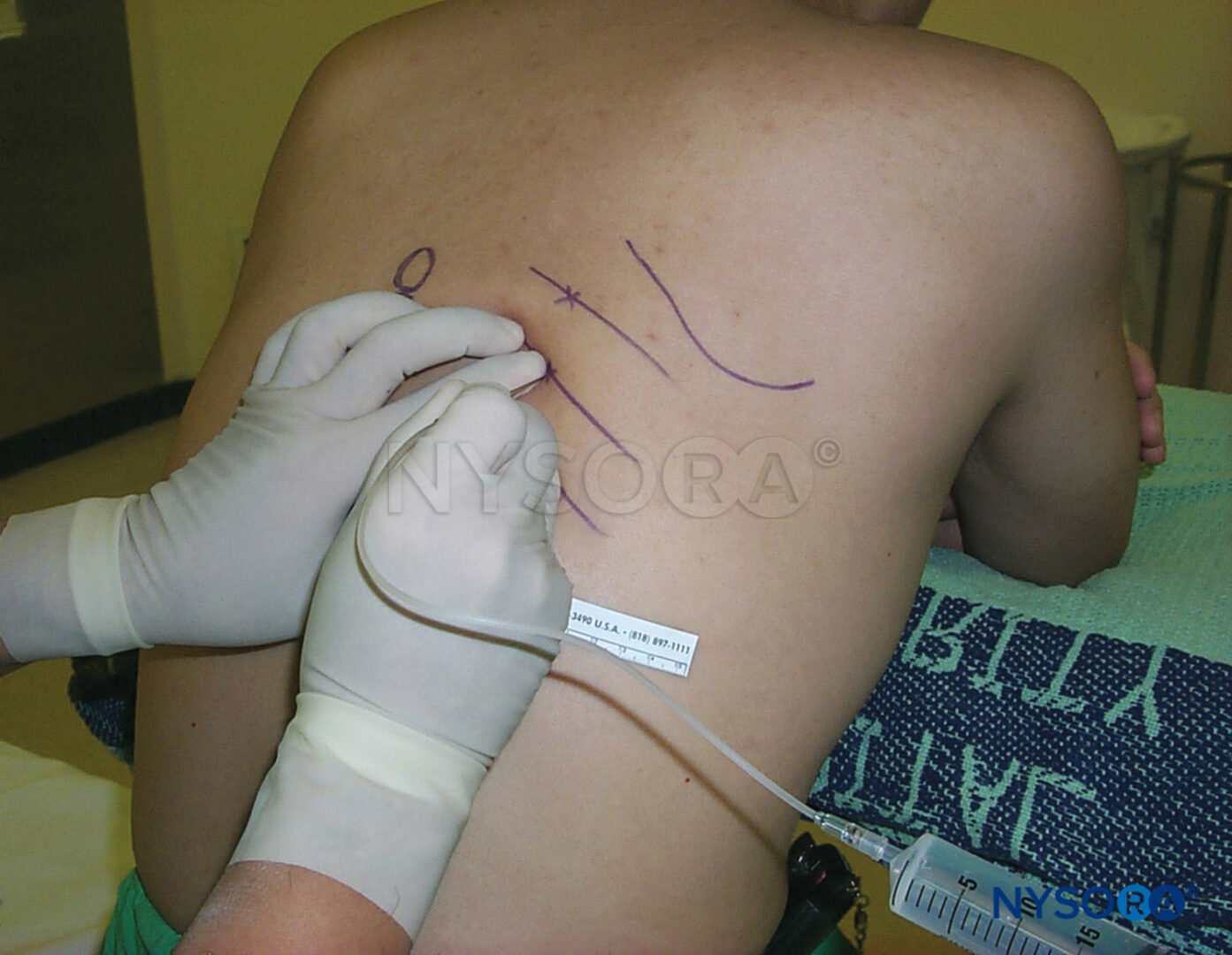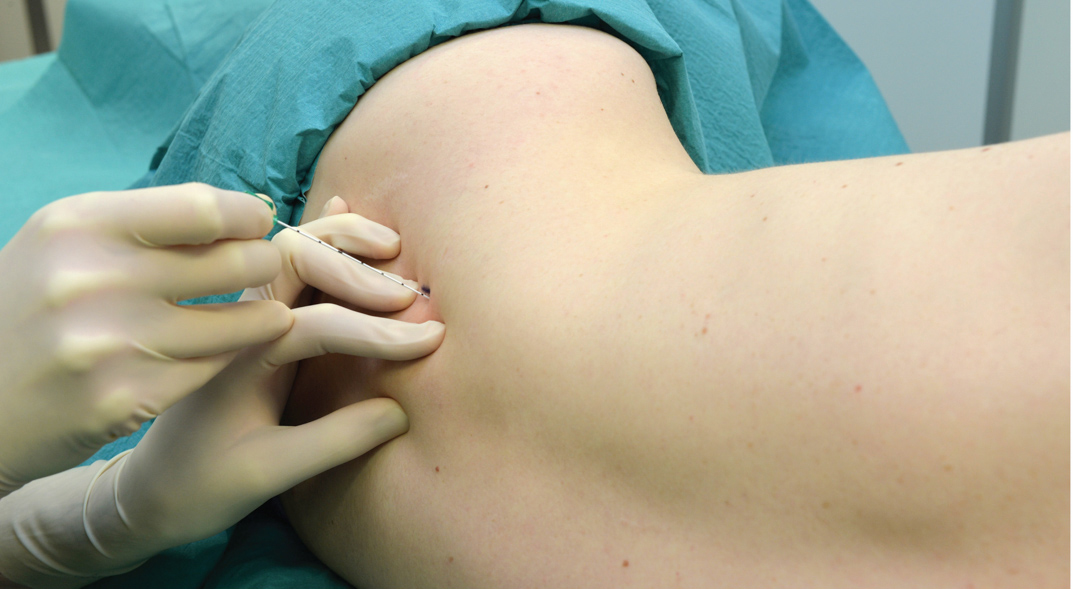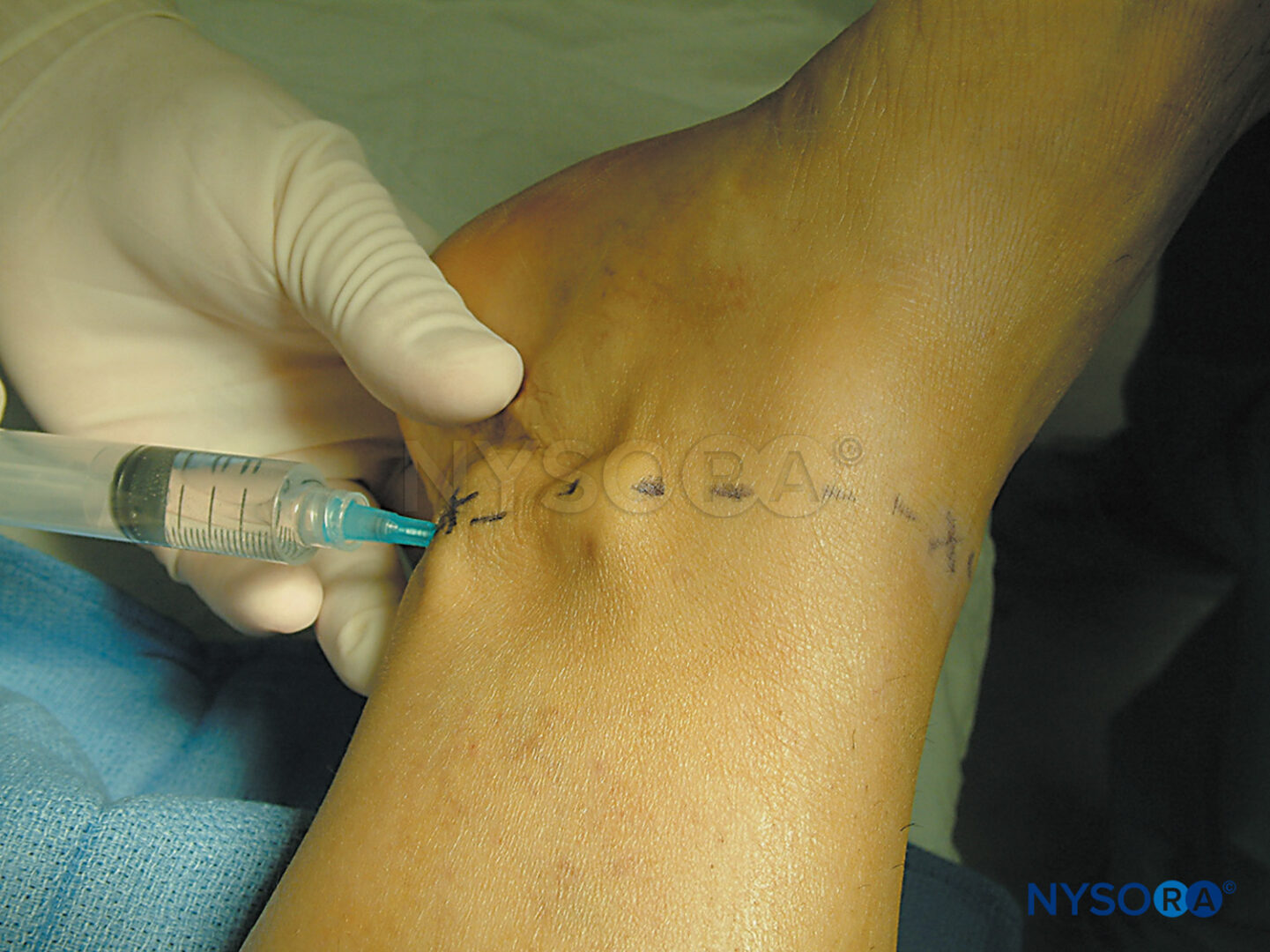Jerry D. Vloka, Admir Hadzic, and Philippe Gautier
INTRODUCTION
The femoral nerve block is one of the most clinically applicable nerve block techniques that it is relatively simple to perform, carries a low risk of complications, and results in a high success rate.
INDICATIONS
Single-Injection Technique
A femoral nerve block is well suited for surgery on the anterior aspect of the thigh and for superficial surgery on the medial aspect of the leg below the knee. Some examples include repair of the quadriceps tendon or quadriceps muscle biopsy, long saphenous vein stripping, and postoperative pain management after femur and knee surgery.
A perineural catheter can be placed to provide prolonged analgesia for patients with fractures on the femoral neck or shaft. Femoral nerve block provides effective analgesia following total knee arthroplasty. A femoral nerve block can also be used to supplement a sciatic or popliteal block to provide complete anesthesia of the lower leg and ankle.
Continuous Technique
The primary indication of continuous femoral nerve block is pain management after major femur or knee surgery. In addition, when compared with a single-dose technique or placebo, continuous femoral nerve block significantly reduces postoperative morphine consumption in patients having a total hip replacement.
Continuous femoral nerve block provides excellent analgesia in patients with femoral shaft or femoral neck fractures. Its relative simplicity makes it uniquely suitable for use to provide analgesia in the emergency room and facilitate physical and radiologic examinations as well as manipulations of the fractured femur or hip. After major knee surgery, continuous femoral nerve block provides better pain relief than parenteral administration of opioids (IV PCA, intramuscular) or intra-articular analgesia. For knee surgery, continuous femoral block is as effective as continuous lumbar plexus block or continuous epidural analgesia but causes fewer complications.
CONTRAINDICATIONS
Relative contraindications for femoral nerve block include previous ilioinguinal surgery (femoral vascular graft, kidney transplantation), large inguinal lymph nodes or tumor, local infection, peritoneal infection, and preexisting femoral neuropathy.
ANATOMY
The femoral nerve is the largest branch of the lumbar plexus. It is formed by the dorsal divisions of the anterior rami of the L2, L3, and L4 spinal nerves. It emerges from the lateral border of the psoas muscle, approximately at the junction of the middle and lower thirds of that muscle. Along with its course to the thigh, it remains deep to the fascia iliaca. It enters the thigh posterior to the inguinal ligament, where it is positioned immediately lateral and slightly posterior to the femoral artery (Figure 1). At this level, it is situated deep to both fascia lata and fascia iliaca (Figure 2). As the nerve passes into the thigh, it divides into anterior and posterior branches (Figure 3). Located above the fascia iliaca, the anterior branches innervate the sartorius and pectineus muscles (Figure 4) and the skin of the anterior and medial aspects of the thigh.
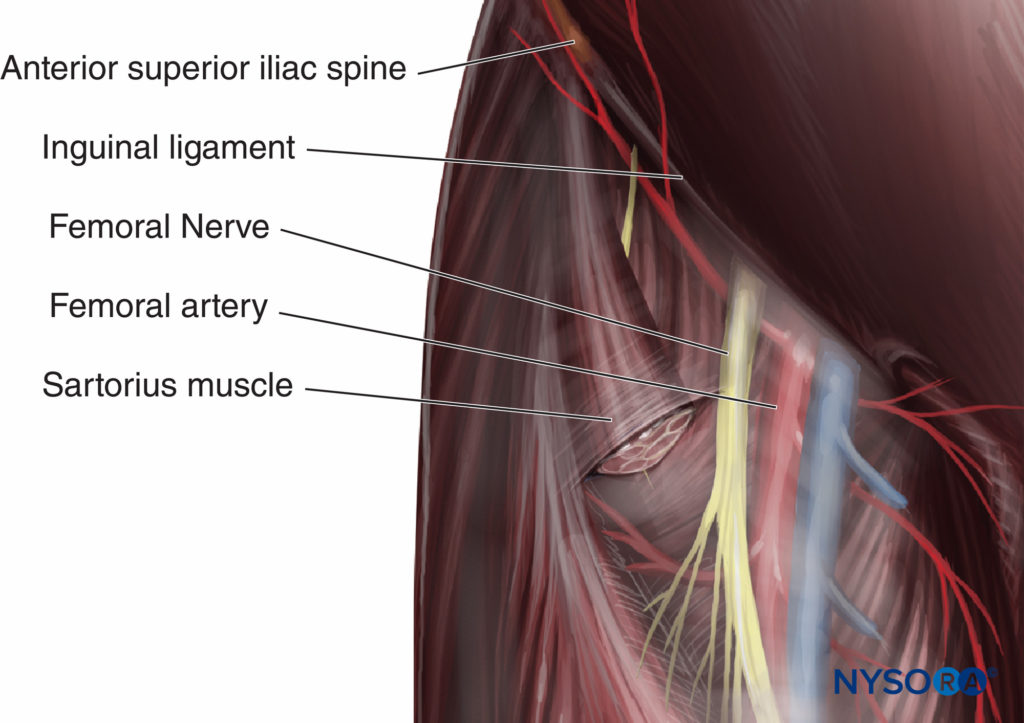
FIGURE 1. Anatomic relationship in the femoral triangle.
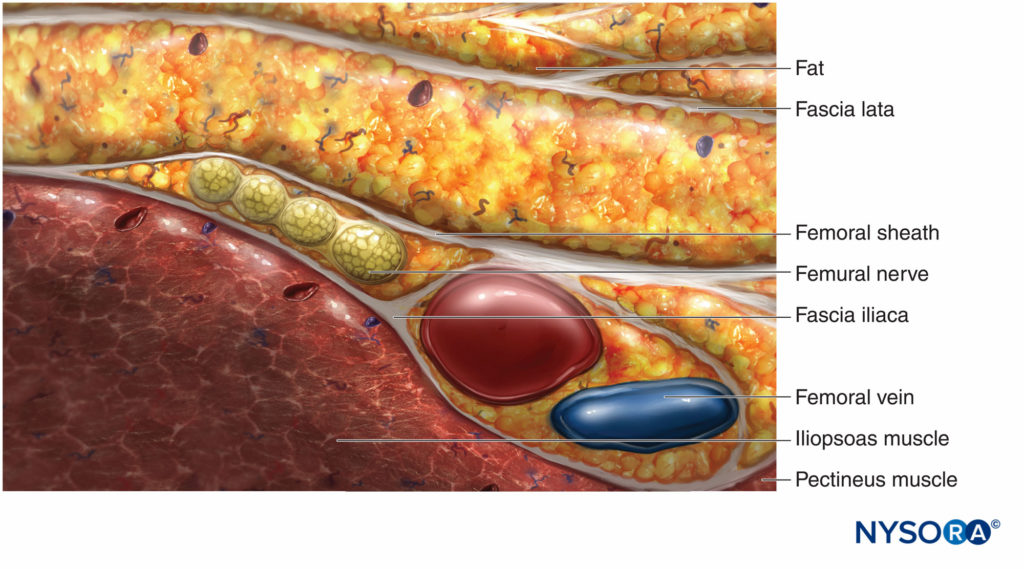
FIGURE 2. Tissue sheaths and femoral nerve, artery and vein relationships.
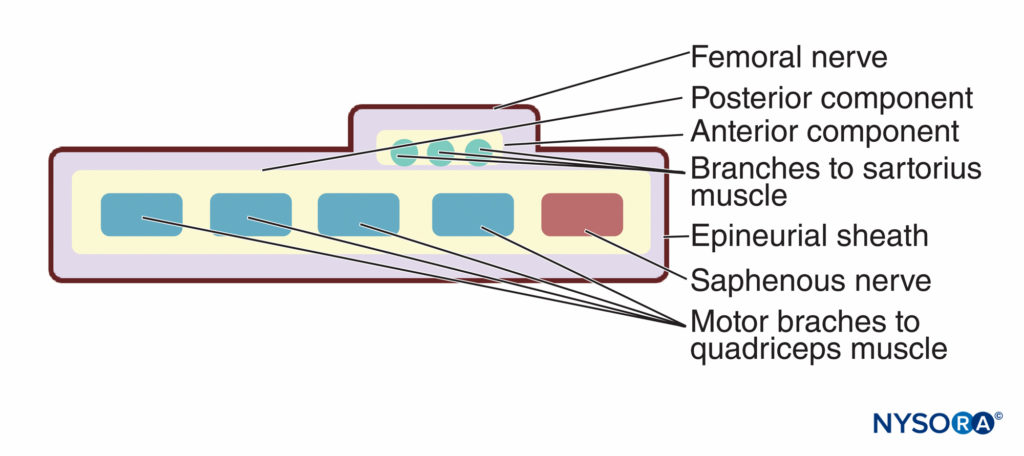
FIGURE 3. Composition of the femoral nerve at the level of block.
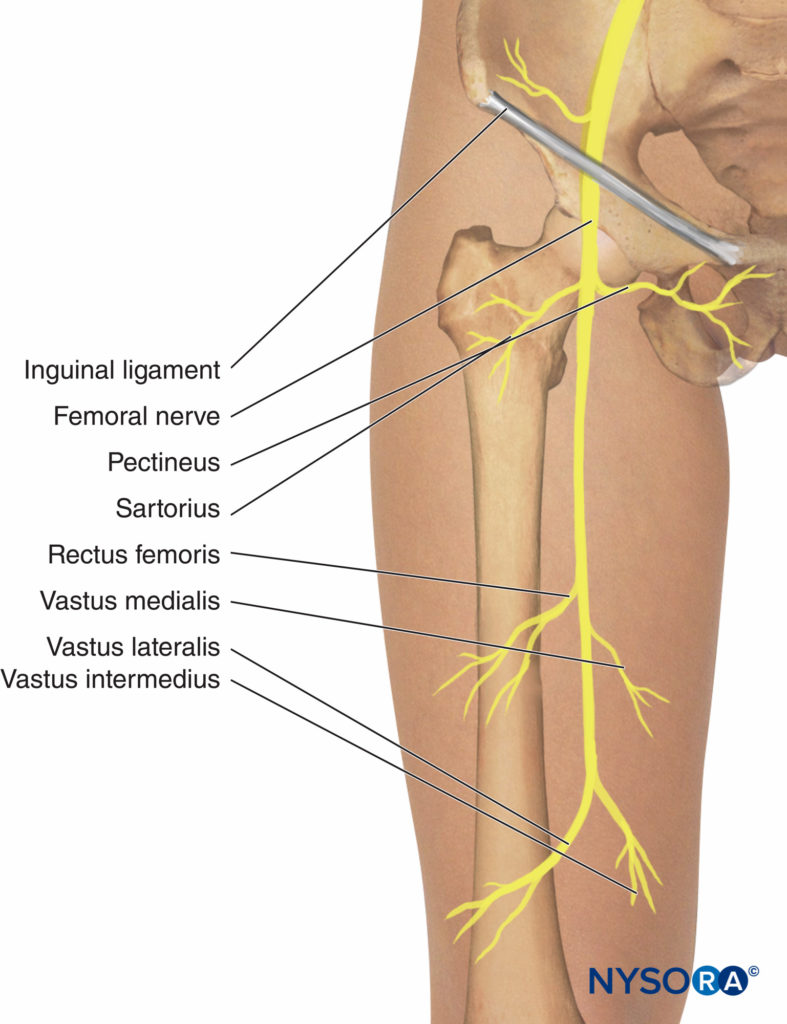
FIGURE 4. Motor branches of the femoral nerve.
NYSORA Tips
In obese patients, the identification of the inguinal crease can be facilitated by asking an assistant to retract the lower abdomen laterally (see Figure 7).
EQUIPMENT
A standard regional anesthesia tray is prepared with the following equipment:
- Sterile towels and gauze packs
- 20-mL syringe with local anesthetic
- Sterile gloves, marking pen
- One 25-gauge, 1.5-in. needle for skin infiltration
- A 5-cm long, short-bevel, insulated stimulating needle
- A peripheral nerve stimulator and a surface electrode
- Injection pressure monitor
Learn more about Equipment for Peripheral Nerve Blocks
BLOCK TECHNIQUE
Patient position. The patient lies in the supine position. The ipsilateral extremity is abducted 10–20 degrees and slightly externally rotated with the lateral side of the foot resting on the table.
The site of needle insertion (Figure 5) is located at the femoral crease but below the inguinal crease and immediately lateral (1 cm) to the pulse of the femoral artery. Located under the fascia iliaca, the posterior branches innervate the quadriceps muscle and the knee joint and give off the saphenous nerve. The saphenous nerve supplies the skin of the medial aspect of the leg below the knee (Figure 6).
Landmarks
The following landmarks are used to determine the site of needle insertion: inguinal ligament, inguinal crease, femoral artery (see Figure 6).
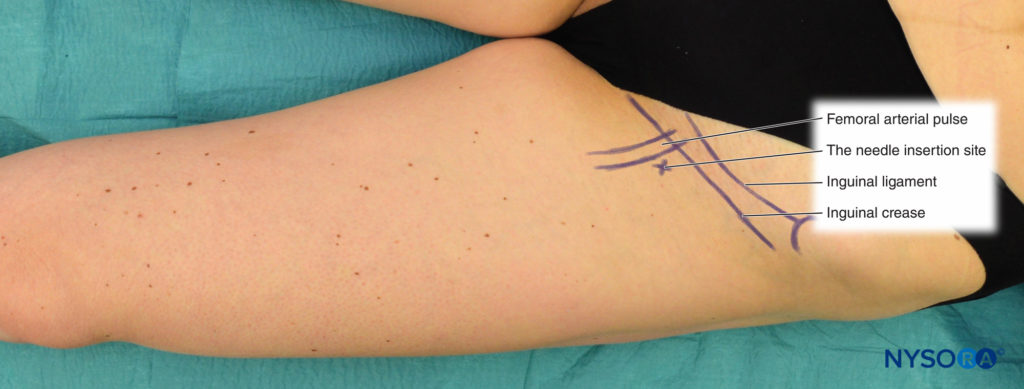
FIGURE 5. Anatomic landmarks for femoral nerve block. The needle insertion site (X) is located just below the inguinal crease, 1–2 cm lateral to the pulse of the femoral artery.
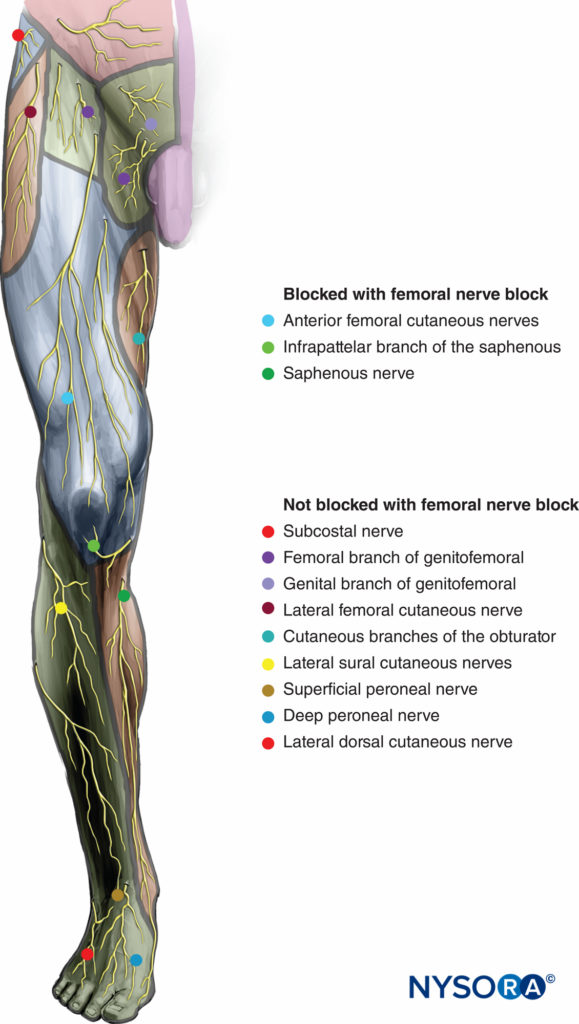
FIGURE 6. Sensory innervation of the femoral nerve and distribution of anesthesia with a femoral nerve block.
NYSORA Tips
- It is useful to think of the mnemonic VAN (vein, artery, nerve) going from medial to lateral when recalling the relationship of the femoral nerve to vessels at the inguinal crease.
- The femoral nerve is approached at the femoral crease, rather than at the inguinal ligament.
Single-Injection Technique
In obese patients, the lower abdomen is retracted laterally to allow access to the inguinal area (Figure 7). The needle is connected to a nerve stimulator set at a current intensity of 1 mA (0.1 msec/2 Hz) and introduced at a 30- to a 45-degree angle to the skin in a cephalad direction (Figure 8).
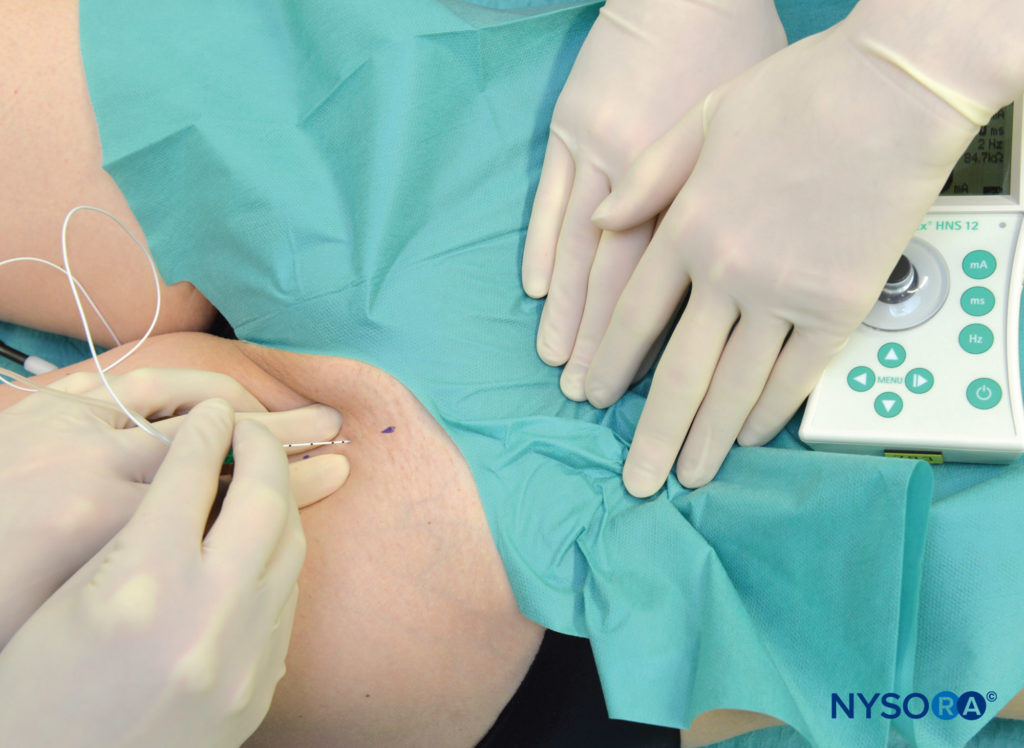
FIGURE 7. The abdomen is retracted laterally to facilitate exposure of the anatomy during femoral nerve block.
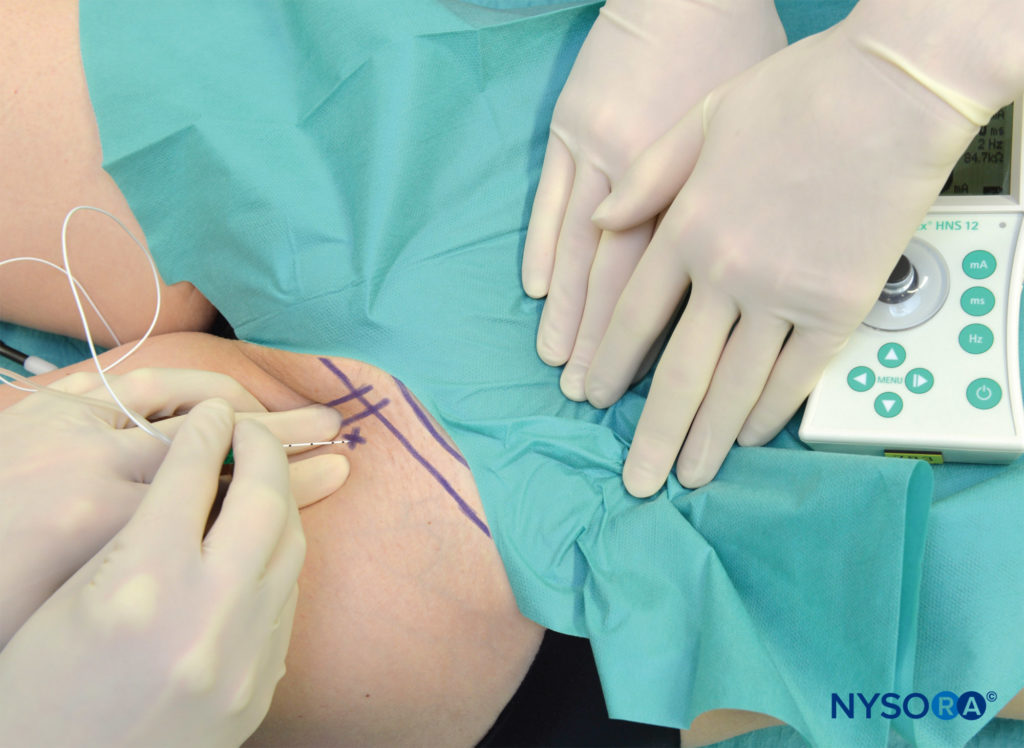
FIGURE 8. The needle is connected to a nerve stimulator set at 1 mA current intensity and introduced at a 30- to 45-degree angle to the skin in a cephalad direction.
The needle is advanced through the fascia lata and iliaca, often associated with a certain feeling of a “pop” as the needle pierces the fasciae. As the quadriceps muscle contractions (i.e., patellar twitch) are obtained, the current is gradually decreased while the needle is advanced. The position of the needle is adequate when patellar twitches are elicited with current output between 0.3 and 0.5 mA. After negative aspiration; 15–20 mL of local anesthetic is injected. Some common responses to nerve stimulation and appropriate action to troubleshoot are featured in Table 1.
TABLE 1. Common responses to nerve stimulation and action to obtain femoral nerve twitch.
| Response Obtained | Interpretation | Problem | Action |
|---|---|---|---|
| No response | The needle is inserted either too medially or to laterally | Femoral artery not properly localized | Follow the systematic lateral angulation and reinsertion of the needle as described in the technique |
| Bone contact | The needle contacts hip or superior ramus of the pubic bone | The needle is inserted too deep | Withdraw to the level of the skin and reinsert in another direction |
| Local twitch | Direct stimulation of the illiopsoas or pectineus muscle | Too deep insertion | Withdraw to the level of the skin and re-insert in another direction |
| Twitch of the sartorius muscle | Sartorius muscle twitch | The needle tip is slightly anterior and medial to the main trunk of the femoral nerve | Redirect the needle laterally and advance deeper 1–3 mm |
| Vascular puncture | Needle placement into the femoral or femoral circumflex artery, less commonly - femoral vein | Too medial needle placement | Withdraw and reinsert laterally 1 cm |
| Patella twitch | Stimulation of the main trunk of the femoral nerve | None | Accept and inject local anesthetic |
Multiple injection techniques have also been described, where vastus lateralis, intermedius, and medialis twitches are individually identified and separate injections of local anesthetic made at each nerve branch. When compared with a single injection, the total volume of local anesthetic required and the block onset time were significantly reduced. However, 14% of patients reported paresthesia, and 28% reported discomfort during block performance. Consequently, this technique has been largely abandoned as being unnecessary.
NYSORA Tips
- The needle tip must be positioned below fascia iliaca to obtain a complete femoral nerve block.
- Larger volume than 15-20 mL is not necessary because it is not associated with a better success rate.
Continuous Femoral Nerve Block
The continuous technique is similar to the single-injection technique. After passage through both fascia lata and iliaca, the needle is advanced to elicit a patellar twitch using a current output between 0.3 and 0.5 mA (0.1 msec) (Figure 9).
The catheter is then inserted 5 cm beyond the tip of the needle and secured in place. After a negative aspiration test for blood, a bolus dose of 10 mL of local anesthetic is injected and followed by a continuous infusion of dilute local anesthetic and/or intermittent boluses of 5 mL hourly. (Figure 10).
- Catheter insertion under the fascia iliaca should be without resistance. When this is not the case, the needle is probably not under the fascia iliaca. The needle should be withdrawn to the skin and reinserted.
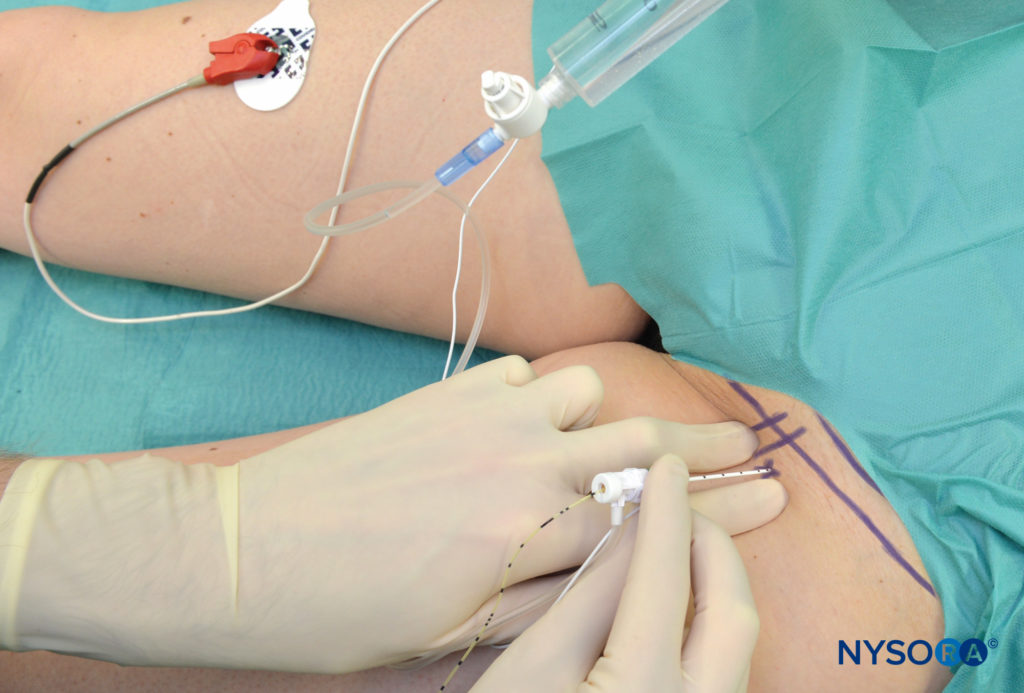
FIGURE 9. Continuous femoral nerve block: Needle insertion.
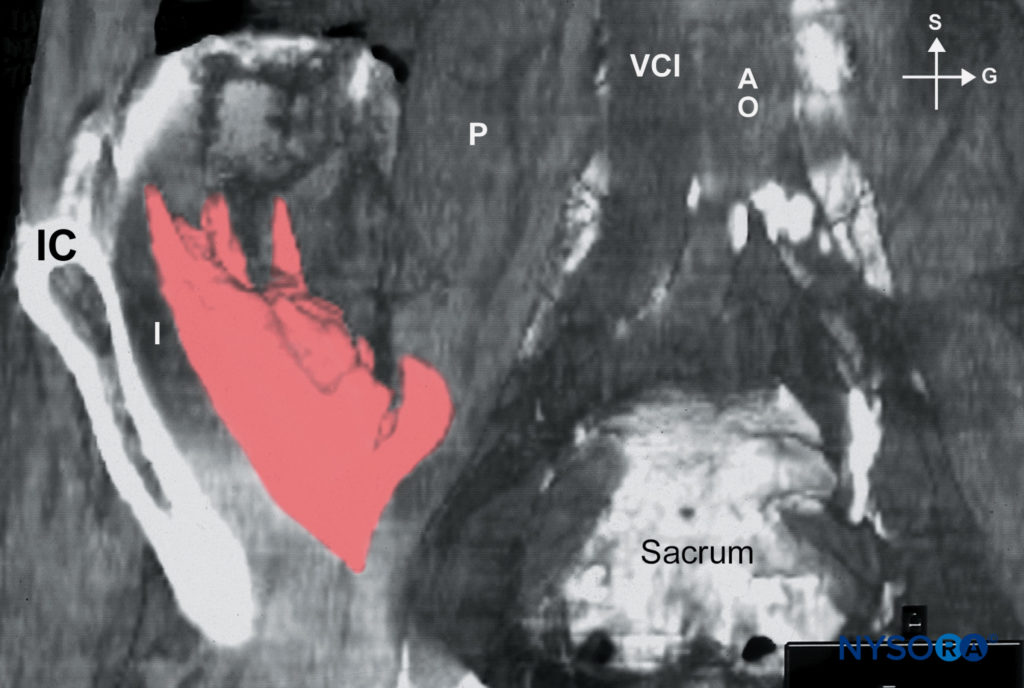
FIGURE 10. Spread of the injectate underneath the fascia iliaca after injection through the femoral catheter. (Used with permission from Dr. Philippe Gautier, Bruxelles, BE.)
Block Assessment
Sensory block is assessed by cold or pinprick test on the anterior and medial aspect of the thigh (femoral nerve) and on the medial aspect of the lower leg (saphenous nerve). Motor block is evaluated by asking the patient to extend the knee (e.g., to elevate the foot from the table).
CHOICE OF LOCAL ANESTHETIC
Single-Injection Technique
For surgical anesthesia, mepivacaine or lidocaine 1.5–2.0% or ropivacaine 0.5%–0.75% are frequently used, depending on the expected duration of surgery. For postoperative analgesia alone, a more dilute concentration of long-acting local anesthetic (eg ropivacaine or bupivacaine 0.2%–0.25%) is appropriate. Onset times and mean duration of both anesthesia and analgesia with different types and concentrations of local anesthetic solution are presented in Table 2.
TABLE 2. Onset and duration of 20 ml of local anesthetic in femoral block.
| Onset (min) | Anesthesia (h) | Analgesia (h) | |
|---|---|---|---|
| 3% 2-Chloroprocaine | 10–15 | 1 | 2 |
| 3% 2-Chloroprocaine (+ HCO3 + epi) | 10–15 | 1.5–2 | 2–3 |
| 1.5% Mepivacaine | 15–20 | 2–3 | 3–5 |
| 1.5% Mepivacaine (+ HCO3 + epi) | 15–20 | 2–5 | 3–8 |
| 2% Lidocaine | 10–20 | 2–5 | 3–8 |
| 0.5% Ropivacaine | 15–30 | 4–8 | 5–12 |
| 0.75% Ropivacaine | 10–15 | 5–10 | 6–24 |
| 0.5 Bupivacaine | 15–30 | 5–15 | 8–30 |
Continuous Technique
The initial bolus of 10–15 mL is followed by an infusion of dilute concentration (e.g., ropivacaine 0.2%). A typical infusion regimen is 5 mL/h basal infusion with a 5 mL/q60min patient-controlled bolus.
For additional information see Continuous Peripheral Nerve Blocks: Local Anesthetic Solutions and Infusion Strategies.
PERIOPERATIVE MANAGEMENT OF FEMORAL NERVE BLOCKS
The performance of femoral nerve block is associated with minor patient discomfort because the needle passes only through the skin and adipose of the inguinal region. Femoral nerve block is associated with weakness of the quadriceps muscle, leading to the decrease in its use in some practices, particularly where ultrasound is available for adductor canal blocks. This is because knee extension and weight-bearing on the blocked side are impaired with femoral nerve block, which must be clearly explained to the patient to reduce the risk of falls. The use of a knee immobilizer for ambulation following femoral nerve block has been shown to reduce the risk of falls, particularly following total knee arthroplasty.
Complications and How to Avoid Them
Complications of femoral nerve block include vascular puncture, femoral nerve compression by a hematoma, diffusion of the local anesthetic solution into the epidural space with the resultant epidural block, catheter shearing, and femoral nerve injury (incidence of 0.25%). With regard to continuous catheters, bacterial contamination of the catheters commonly occurs after 48 hours. However, local or systemic infection remains rare, with the estimated risk of 0.13%, Table 3.
TABLE 3. Femoral nerve block: complications.
| Hematoma | • When the femoral artery or vein is punctured, the procedure should be stopped and pressure applied over the puncture site for 2–3 min |
| Vascular puncture | • Maintain a palpating finger on the femoral pulse and insert the needle just lateral and parallel to the pulse. • The needle should never be directed medially. |
| Nerve injury | • Use a nerve stimulator avoid injection when motor response is present at <0.3 mA (0.1 msec). • Do not seek paresthesia as method of localization of FN because paresthesia is rarely elicited with femoral nerve block and should not be sought or relied on to indicate an intraneural injection. However, should severe pain on injection be reported, abort the injection. • Do not inject when high pressures on injection are encountered. • Use the minimal efficient volume and concentration of local anesthetic (15-20 mL). |
| Catheter infection | • Use strict aseptic technique during catheter insertion. • Sterile drapes should be used with continuous techniques. • Remove the catheter after 48–72 h (risk of infection increases with time). |
| Prevention of Falls | • Instruct patient on the inability to bear weight on the blocked extremity. |
SUMMARY
A femoral nerve block is easy to perform and associated with a low risk of complications. It is suitable for catheter insertion. When used alone, it is effective for surgery on the anterior thigh and for postoperative pain management after femur and knee surgery. When combined with sciatic and/or obturator nerve blocks, anesthesia of almost the entire lower limb from the midthigh level can be achieved.
Supplementary material related to this block can be found at Femoral Nerve Block Video and Ultrasound-guided femoral nerve block
REFERENCES
- Kwofie MK, Shastri UD, Gadsden JC, et al: The effects of ultrasound-guided adductor canal block versus femoral nerve block on quadriceps strength and fall risk: a blinded, randomized trial of volunteers. Reg Anesth Pain Med 2013;38:321–325.
- Jæger P, Zaric D, Fomsgaard JS, et al: Adductor canal block versus femoral nerve block for analgesia after total knee arthroplasty: a randomized, double-blind study. Reg Anesth Pain Med 2013;38:526-532.
- Shah NA, Jain NP: Is continuous adductor canal block better than continuous femoral nerve block after total knee arthroplasty? effect on ambulation ability, early functional recovery and pain control: a randomized controlled trial. J Arthroplasty 2014 Jun 19. pii: S0883-540 [Epub ahead of print]
- Perlas A, Kirkham KR, Billing R, et al: The impact of analgesic modality on early ambulation following total knee arthroplasty. Reg Anesth Pain Med 2013;38:334–339.
- Anker-Møller E, Spangsberg N, Dahl J, et al: Continuous block of the lumbar plexus after knee surgery: a comparison of the plasma concentrations and analgesic effect of bupivacaine 0.250% and 0.125%. Acta Anaesthesiol Scand 1990;34:468–472.
- Ganapathy S, Wasserman R, Watson J, et al: Modified continuous femoral three-in-one block for postoperative pain after total knee arthroplasty. Anesth Analg 1999;89:1197–1202.
- Singelyn F, Gouverneur JM: Extended “3-in-1” block after total knee arthroplasty: continuous versus patient-controlled techniques. Anesth Analg 2000;91:176–180.
- Eledjam JJ, Cuvillon P, Capdevila X, et al: Postoperative analgesia by femoral nerve block with ropivacaine 0.2% after major knee surgery: continuous versus patient-controlled techniques. Reg Anesth Pain Med 2002;27:604–611.
- Singelyn F, Vanderelst P, Gouverneur JM: Extended femoral nerve sheath block after total hip arthroplasty: continuous vs patient-controlled techniques. Anesth Analg 2001;92:455–459.
- Tetzlaff J, Andrish J, O’Hara J, et al: Effectiveness of bupivacaine administered via femoral nerve catheter for pain control after anterior cruciate ligament repair. J Clin Anesth 1997;9:542–545.
- Capdevila X, Barthelet Y, Biboulet P, et al: Effects of perioperative analgesic technique on the surgical outcome and duration of rehabilitation after major knee surgery. Anesthesiology 1999;91:8–15.
- Singelyn F, Gouverneur JM: Postoperative analgesia after total hip arthroplasty: IV PCA with morphine, patient-controlled epidural analgesia, or continuous “3-in-1” block? A prospective evaluation by our acute pain service in more than 1300 patients. J Clin Anesth 1999;11:550–554.
- Ben-David B, Croituru M: Psoas block for surgical repair of hip fracture: a case report and description of a catheter technique. Anesth Analg 1990;71:298–301.
- Capdevila X, Biboulet P, Bouregba M, et al: Bilateral continuous 3-in-1 nerve block for postoperative pain relief after bilateral femoral shaft surgery. J Clin Anesth 1998;10:606–609.
- Serpell M, Millar F, Thomson M: Comparison of lumbar plexus block versus conventional opioid analgesia after total knee replacement. Anaesthesia 1991;46:275–277.
- Dahl J, Christiansen C, Daugaard J, et al: Continuous block of the lumbar plexus after knee surgery—postoperative analgesia and bupivacaine plasma concentrations. Anaesthesia 1988;43:1015–1018.
- De Andrés J, Bellver J, Barrera L, et al: A comparative study of analgesia after knee surgery with intraarticular bupivacaine, intraarticular morphine, and lumbar plexus block. Anesth Analg 1993;77:727–730.
- Schultz P, Christensen E, Anker-Møller E, et al: Postoperative pain treatment after open knee surgery: continuous lumbar plexus block with bupivacaine versus epidural morphine. Reg Anesth Pain Med 1991;16:34–37.
- Singelyn F, Deyaert M, Joris D, et al: Effects of intravenous patient-controlled analgesia with morphine, continuous epidural analgesia, and continuous “3-in-1” block on postoperative pain and knee rehabilitation after unilateral total knee arthroplasty. Anesth Analg 1998;87:88–92.
- Johnson C: Continuous femoral nerve block for analgesia in children with femoral fractures. Anaesth Intensive Care 1994;22:281–283.
- Capdevila X, Biboulet P, Bouregba M, et al: Comparison of the three- in-one and fascia iliaca compartment blocks in adults: clinical and radiographic analysis. Anesth Analg 1998;86:1039–1044.
- Singelyn FJ, Ebongo F, Symens B, et al: Influence of the analgesic technique on postoperative rehabilitation after total hip replacement. Reg Anesth Pain Med 2001;26–39.
- Boujlel S, Delbos A, Singelyn F: Continuous but not single-dose femoral nerve sheath block provides efficient pain relief after total hip replacement (THR). Reg Anesth Pain Med 2001;26–135.
- Chudinov A, Berkenstadt H, Salai M, et al: Continuous psoas compartment block for anesthesia and perioperative analgesia in patients with hip fractures. Reg Anesth Pain Med 1999;24:563–568.
- Dauri M, Polzoni M, Fabbi E, et al: Comparison of epidural, continu- ous femoral block and intraarticular analgesia after anterior cruciate ligament reconstruction. Acta Anaesthesiol Scand 2003;47:20–25.
- Kaloul I, Guay J, Côtré C, et al: The posterior lumbar plexus (psoas compartment) block and the three-in-one femoral nerve block provide similar postoperative analgesia after total knee replacement. Can J Anaesth 2004;51:45–51.
- Chelly J, Greger J, Gebhard R, et al: Continuous femoral blocks improve recovery and outcome of patients undergoing total knee arthroplasty. J Arthroplasty 2001;16:436–445.
- Winnie AP, Ramamurthy S, Durrani Z: The inguinal paravascular technic of lumbar plexus anesthesia. The “3-in-1 block.” Anesth Analg 1973;52:989–996.
- Vloka JD, Hadzic A, Drobnik L, et al Anatomical landmarks for femoral nerve block: a comparison of four needle insertion sites. Anesth Analg 1999;89:1467–1470.
- Casati A, Fanelli G, Beccaria P, et al: The effects of single or multiple injections on the volume of 0.5% ropivacaine required for femoral nerve block. Anesth Analg 2001;93:183–186.
- Casati A, Fanelli G, Beccaria P, et al: The effects of the single or multiple injection technique on the onset time of femoral nerve block with 0.75 % ropivacaine. Anesth Analg 2000;91:181–184.
- Fanelli G, Casati A, Garancini P, et al: Nerve stimulator and multi- ple injection technique for upper and lower limb block: Failure rate, patient acceptance and neurologic complications. Anesth Analg 1999;88:847–852.
- Seeberger M, Urwyler A: Paravascular lumbar plexus block: Block extension after femoral nerve stimulation and injection of 20 vs. 40 mL mepivacaine 10 mg/mL. Acta Anaesthesiol Scand 1995;39: 769–773.
- Beebe MJ, Allen R, Anderson MB, et al: Continuous femoral nerve block using 0.125% bupivacaine does not prevent early ambulation after total knee arthroplasty. Clin Orthop Relat Res. 2014;472:1394–1399.
- Cui Q, Schapiro LH, Kinney MC, et al: Reducing costly falls of total knee replacement patients. Am J Med Qual. 2013;28:335–338. Epub 2013 Jan 15.
- Jôhr M: A complication of continuous femoral nerve block. Reg Anaesth 1987;10:37–38.
- Singelyn F, Contreras V, Gouverneur JM: Epidural anesthesia complicating continuous 3-in-1 lumbar plexus block. Anesthesiolgy 1995;83: 217–220.
- Lee B, Goucke C: Shearing of a peripheral nerve catheter. Anesth Analg 2002;95:760–761.
- Cuvillon P, Ripart J, Lalourcey L, et al: The continuous femoral nerve block catheter for postoperative analgesia: bacterial colonization, infectious rate and adverse effects. Anesth Analg 2001;93:1045–1049.
- Pirat P, Branchereau S, Bernard N, et al: Suivi prospectif descriptif des effets adverses non infectieux liés aux blocs nerveux périphériques continus: á propos de 1416 patients. Ann Fr Anesth Réanim 2002; 21:R010.
- Bernard N, Pirat P, Branchereau S, et al: Suivi multicentrique prospectif des effets adverses d’ordre infectieux sur 1416 blocs nerveux périphériques continus. Ann Fr Anesth Réanim 2002;21:R076.



